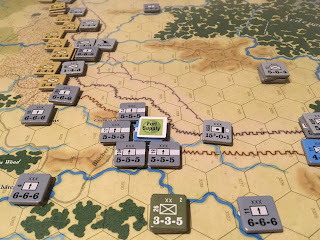1918 / 1919 Storm in the West
Ted Racer is one of the elder statesmen of board war gaming
and best known for rehabilitating WW1 as a gaming topic. In the early 90s the
short lived Command Magazine by XTR Corp published three of his titles, two on
1914 and one on 1918.
 |
| And so it begins |
Fast forward just under 20 years and GMT is in the market
for republishing some older titles. In 2014 they republished the two 1914
titles in a dual pack and in 2020 they dressed up 1918 from a magazine game to
a full boxed game and republished it. The dressing up here is updated graphics,
a very clear rule book and the 1919 alt-history second scenario.
The system is very vanilla but very effective; igo-ugo,
ratio CRT, fairly sticky ZOCs, reinforcement schedule. Unit scale is mostly
corps, turns are two weeks, hexes 8 miles. Like many of Mark Simonitch's ‘4X
WW2 titles the quality is in the execution and the tweaks to the system rather
than core innovation.
The key tweak here is manpower. Both the central powers and
the Allies were running short on population by 1918 (or 1919). Each turn both
sides can reconstitute damaged or destroyed corps by spending their manpower,
but once it’s gone, it’s gone. This gives both sides a pacing vs reserves
problem to solve.
The players can free setup their forces for either scenario
and have a range of victory point hexes to shoot for. It is therefore a fairly
open game possibly suitable for tournament play or unorthodox strategies. The
Germans have to swing first using their stross troopen to infiltrate and grab a
set number of VPs before turn 9 or they lose the game. If the game runs longer
than 9 turns the allies have to near clean the Germans off the map. The tide
comes in and then it goes out.
This ticks all the boxes player love; balanced situation,
both sides can attack, simple rules but reasonable simulation, justifiable play
time of 4-6 hours, lots of replay and decision making. On the weaknesses tally some
turns can be rather quiet for one player or another, as in they do nothing that
turn, and the reinforcement rules require units to walk onto the map edge,
before getting on a train for strategic movement.
Obviously I recommend this one. Best WW1 game I have played.


Comments
Post a Comment